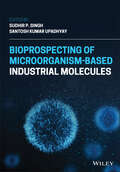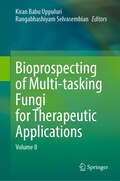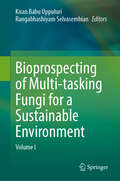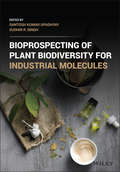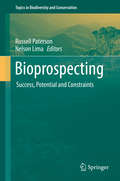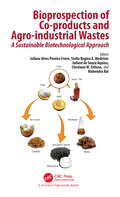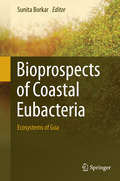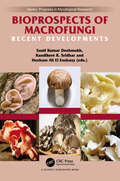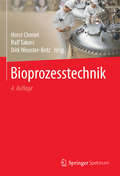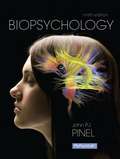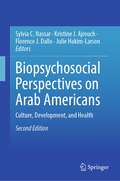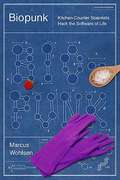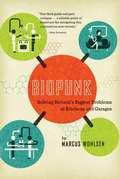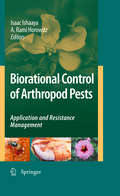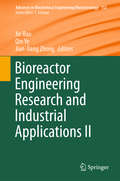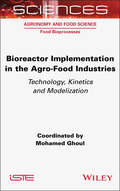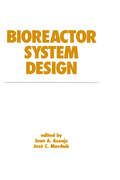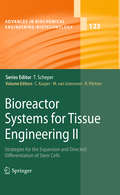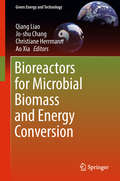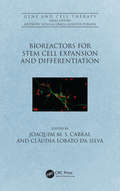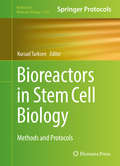- Table View
- List View
Bioprospecting of Microorganism-Based Industrial Molecules
by Sudhir P. Singh Santosh Kumar UpadhyayDiscover a comprehensive and current overview of microbial bioprospecting written by leading voices in the field In Bioprospecting of Microorganism-Based Industrial Molecules, distinguished researchers and authors Sudhir P. Singh and Santosh Kumar Upadhyay deliver global perspectives of bioprospecting of biodiversity. The book covers diverse aspects of bioprospecting of microorganisms demonstrating biomass value of nutraceutical, pharmaceutical, biomedical, and bioenergetic importance. The authors present an amalgamation of translational research on bioresource utilization and ecological sustainability that will further the reader’s knowledge of the applications of different microbial diversity and reveal new avenues of research investigation. Readers will also benefit from: A thorough introduction to microbial biodiversity and bioprospecting An exploration of anti-ageing and skin lightening microbial products and microbial production of anti-cancerous biomolecules A treatment of UV protective compounds from algal biodiversity and polysaccharides from marine microalgal sources Discussions of microbial sources of insect toxic proteins and the role of microbes in bio-surfactants production Perfect for academics, scientists, researchers, graduate and post-graduate students working and studying in the areas of microbiology, food biotechnology, industrial microbiology, plant biotechnology, and microbial biotechnology, Bioprospecting of Microorganism-Based Industrial Molecules is an indispensable guide for anyone looking for a comprehensive overview of the subject.
Bioprospecting of Multi-tasking Fungi for Therapeutic Applications: Volume II
by Rangabhashiyam Selvasembian Kiran Babu UppuluriThis book covers the multi-tasking nature of fungi for therapeutic applications. It emphasizes the simultaneous metabolic activities and functions of fungi for producing enzyme inhibitors, therapeutic molecules and other biomedical utilities like polymers, nano-composites and biosensors. The fungi are involved in the production of many therapeutically-potent secondary metabolites and polymers. The recent research on fungal bioprospecting is more focused on sustainable solutions for diverse industries and markets for the circular economy. This book also offers current and future research perspectives of fungal bioprospecting. The potential of fungi to act as a bioresource for antimicrobial, antiviral, anticancer, antiprotozoal and antituberculosis compounds has also been discussed. This book is a reference material for undergraduate students for gaining in-depth knowledge on fungal bioprospecting, particularly fungi's multi-tasking nature.
Bioprospecting of Multi-tasking Fungi for a Sustainable Environment: Volume I
by Rangabhashiyam Selvasembian Kiran Babu UppuluriThis book highlights the types and importance of multitasking fungi and provides critical analysis of fungi involved in production of important enzymes. It also covers additional tasks of fungi such as biosorption, remediation, soil fertilization, and water treatment. This book discusses the types of fungi, their cultivation, execution of multitasking, and the analysis and recovery of products. This information can be used to understand and improve the effectiveness and efficiency of fungi in the production of a variety of products, such as antibiotics, enzymes, and biofuels. This book would be of interest to researchers working in industrial biotechnology, fungal physiology, environmental sciences and technology, sustainable technologies, and agricultural sciences.
Bioprospecting of Plant Biodiversity for Industrial Molecules
by Sudhir P. Singh Santosh Kumar UpadhyayBIOPROSPECTING OF PLANT BIODIVERSITY FOR INDUSTRIAL MOLECULES A comprehensive collection of recent translational research on bioresource utilization and ecological sustainability Bioprospecting of Plant Biodiversity for Industrial Molecules provides an up-to-date overview of the ongoing search for biodiverse organic compounds for use in pharmaceuticals, bioceuticals, agriculture, and other commercial applications. Bringing together work from a panel of international contributors, this comprehensive monograph covers natural compounds of plants, endophyte enzymes and their applications in industry, plant bioprospecting in cosmetics, marine bioprospecting of seaweeds, and more. Providing global perspectives on bioprospecting of plant biodiversity, the authors present research on enzymes, mineral micro-nutrients, biopesticides, algal biomass, and other bioactive molecules. In-depth chapters assess the health impacts and ecological sustainability of the various biomolecules and identify existing and possible applications ranging from ecological restoration to production of essential oils and cosmetics. Other topics include, bio-energy crops as alternative fuel resources, the role of plants in phytoremediation of industrial waste, and the industrial applications of endophyte enzymes. This comprehensive resource: Includes a through introduction to plant biodiversity and bioprospecting Will further the knowledge of application of different plants and improve research investigation techniques. Summarizes novel approaches for researchers in food science, microbiology, biochemistry, and biotechnology Bioprospecting of Plant Biodiversity for Industrial Molecules is an indispensable compendium of biological research for scientists, researchers, graduate and postgraduate students, and academics in the areas of microbiology, food biotechnology, industrial microbiology, plant biotechnology, and microbial biotechnology.
Bioprospecting of Tropical Medicinal Plants
by Xuefei Yang Karuppusamy Arunachalam Sreeja Puthanpura SasidharanThis book focuses on natural products, in particular medicinal plants and their derived products, as an indispensable source of bioactive molecules that serve as either drug candidates or lead compounds for drug design and discovery . There are several advantages for plant-derived therapeutics, including wide availability, diverse pharmacological actions, and a generally good profile of safety and tolerability. Over the recent years, there have been numerous reports from clinical studies testifying the efficacy and safety of medicinal plants and phytochemicals in treating human diseases. A plethora of basic studies has also unraveled molecular mechanisms underlying the health benefits of herbal medicines. Nevertheless, issues such as identification of bioactive ingredients, standardization of the products, and drug interactions remain to be systematically documented. Bioprospecting of Tropical Medicinal Plants represents a comprehensive analysis of natural products, mainly medicinal plants and phytochemicals. It includes detailed medicinal properties and pharmacological action from in vitro models to clinical trials. The goal is to present the readers a carefully curated collection of plant-derived natural products and their underlying molecular mechanisms.
Bioprospecting: Success, Potential and Constraints (Topics in Biodiversity and Conservation #16)
by Russell Paterson Nelson LimaThis book considers all aspects of bioprospecting in 14 succinct chapters and a forward by David Hawksworth. The organisms addressed include plants, insects, fungi, bacteria and phages. Bioprospecting has never been more relevant and is of renewed interest, because of the extremely worrying rise in novel, resistant pathogenic microorganisms. The practices in pharmaceutical companies have failed to deliver novel antibiotics to control these infections. We need to look for new sources of drugs from the environment on a massive scale as drug discovery is "too important to fail". Furthermore, the field can add great value to ecosystems in terms of economics, while providing additional reasons for maintaining associated services, such as food provision, benign climate, effective nutrient cycling and cultural practices. Bioprospecting provides another reason why climate change must be reduced in order to preserve relevant environments. Previous bioprospecting projects should be re-visited and established biodiversity centres have a major role. Many different ecosystems exist which contain unique organisms with the potential to supply novel antibiotics, enzymes, food, and cosmetics, or they may simply have aesthetic value. The book stresses the difficulties in obtaining successful products and yet describes why natural products should be investigated over combinatorial chemistry. Personal experience of bioprospecting projects are given significance. Issues such as how to share the benefits equitably with local communities are described and why pharmaceutical companies can be reluctant to be involved. Legal issues are discussed. Finally, there has never been a better time for a new book on bioprospecting, because of the need to preserve ecosystems, and from the emergence of resistant pathogenic microorganisms.
Bioprospection of Co-products and Agro-industrial Wastes: A Sustainable Biotechnological Approach
by Mahendra Rai Chistiane M. Feitosa Joilane Alves Pereira Freire Stella Regina A. Medeiros Jailane de Souza AquinoThe proposed book titled as “Bioprospection of Coproducts and Agro-industrial Wastes: A Sustainable Biotechnological Approach”, seeks to offer the importance of the recycling, reuse of food residue, byproducts of fruits and agri-wastes to the academic community and industries. In developing countries facing malnutrition and environmental problems, this book would be very useful. The food waste and the residues resulting from this process are now becoming environmental problems. These mainly include leaves, stems, seeds, bark, and roots that have high nutritional value, many times even greater than the part usually consumed. It is a pressing priority to reuse and recycle the waste which is detrimental to the environment. This book would be an essential reading for students, researchers, and people from the food and pharma industry.
Bioprospects of Coastal Eubacteria: Ecosystems of Goa
by Sunita BorkarThis book is a collection of scholarly articles presenting the research results of work carried out under the supervision of Prof. Saroj Bhosle, a microbiologist at Goa University, India. The objective of this volume is to document the comprehensive ecological knowledge of eubacteria isolated from diverse coastal ecosystems of Goa, little explored for microbiological studies. These ecosystems need to be properly tapped in order to reveal potential bacteria yet to be exploited. The topics of this book are particularly relevant to researchers and students in the field of microbiology with an interest in the varied aspects of eubacteria. They provide academic insight for scientific communities in Goa and the rest of the world.
Bioprospects of Macrofungi: Recent Developments (Progress in Mycological Research)
by Sunil Kumar Deshmukh Kandikere R. Sridhar Hesham Ali El EnshasyThe discipline of mycology is a fascinating one. It has a major influence on the nutrition, health and environmental safety of mankind. Cultivation of edible and non-edible mushrooms for nutrition, pharmaceuticals, biopolymers and biocomposites will open up new avenues in research as well as the more profitable utilization of agricultural residues. Cultivation and of domesticated and wild mushrooms poses a challenge to fulfill the needs of human/animal nutrition and utilization of agrowastes tangibly. Cultivation of ectomycorrhizal fungi benefits nutrition as well as plant protection. Macrofungi are the major source of several metabolites of nutritional, health, agricultural and industrial significance (e.g., antioxidants, antimicrobials and pigments). Macrofungal bio composites provide alternatives to the use of animal-derived or plant-derived products (e.g., nanopapers, leather and packaging materials). They serve a dual role in providing nutrition and pharmaceuticals (nutraceuticals) to humans as well as livestock. Macrofungi interact with insects symbiotically (e.g., Termitomyces with termites) and provide delicious nutraceutical product. They also control insects by infecting and producing pharmaceutically and metabolite-rich products (e.g., Cordyceps attacks insects). Macrofungi have a strong potential to control pathogens like nematodes in soil (bioremediation). They are also useful as biofertilizers to meet the needs of plant nutrition. The book outlines current advances in macrofungal technology. It highlights different facets of macrofungal cultivation, bioactive compounds, biocomposites, nutraceuticals, benefits with interaction with insects, application as biofertilizers and ecosystem services like bioremediation.
Bioprozesstechnik
by Ralf Takors Wolfgang Zettlmeier Horst Chmiel Dirk Weuster-BotzDieses Werk wurde erstmals 1991 von Horst Chmiel herausgegeben und hat sich inzwischen als Standardwerk sowohl im Studium als auch in der Praxis der Biotechnologie etabliert. Die in weiten Teilen neue 4. Auflage des Lehrbuchs Bioprozesstechnik bietet eine umfassende Einführung zu allen Aspekten der modernen Bioprozesstechnik. Am Anfang stehen Beiträge zur Kinetik von Enzymen und Mikroorganismen, gefolgt von einem Kapitel zu Prozessmodellen. Weitere Beiträge beschäftigen sich mit den Fließeigenschaften von Biosuspensionen und deren Einfluss auf Transportvorgänge. Die Funktionsweise von Bioreaktoren und das Problem der Sterilität sowie die Mess- und Regeltechnik werden ausführlich behandelt. Oftmals entfallen mehr als die Hälfte der Kosten eines Bioprodukts auf die Aufarbeitung, ihr wird deshalb besondere Beachtung geschenkt. Der Beschreibung von ausgewählten Bioprozessen sind drei Kapitel gewidmet, bevor das Buch mit einem Beitrag zu systembiologischen Aspekten der Bioprozesstechnik abgeschlossen wird.
Biopsychology
by John P. J. PinelDelves into how the central nervous system governs behavior Biopsychology, 9/e, introduces the study of the biology of behavior; that is, the neural mechanisms of psychological processes in the central nervous system. This program combines biopsychogical science and student-oriented discussion, interweaving the basics of this specialized field with clinical case studies and exploring the personal and social implications that arise. The author encourages interactive learning and creative thinking. His clear and engaging presentation makes the material personally and socially relevant to readers.
Biopsychology: The Basics (The Basics)
by Philip Winn Madeleine GrealyBiopsychology: The Basics is a concise, accessible and illuminating introduction to the field of biopsychology. The book explores what psychology is in the broadest sense and how combining it with a biological perspective offers a deeper understanding of behavior and mental life. Key topics include the following:• What biopsychology is: understanding the interaction of biology and psychology• The biology of the brain and how to study it• How psychological states are related to physiological processes• The effects of drugs, both therapeutic and recreational, on behaviour and psychology• How genes and the environment impact psychological development• The biopsychology of cognition• People in the world: understanding emotions, motivation and communication• The biological basis of psychopathologies – causes, diagnoses and treatments• Explanations, mechanisms and the biopsychology of consciousnessWith suggestions for further reading and an extensive glossary of key terms, this book is an engaging and ideal introduction for those coming to the subject for the first time.
Biopsychosocial Perspectives on Arab Americans: Culture, Development, and Health
by Kristine J. Ajrouch Julie Hakim-Larson Sylvia C. Nassar Florence J. DalloThe biopsychosocial study of Arab Americans yields compelling insights into innovative theoretical and applied initiatives. In the context of a growing population of Arab Americans, coupled with the current tenure of xenophobia and exposed structural racism in the US, clinical and community practitioners must be attuned to their clients of Arab ancestry, whose experiences, development, and health concerns are distinctly different than that of their White counterparts. This second edition, with its uniquely interwoven sections of culture, psychosocial development, and health and disease, provides a rich overview of timely, critical topics. The audience for the text includes counselors, social workers, psychologists, nurses, psychiatrists, sociologists, and any other public and mental health practitioners, researchers, and policy makers who work with and on behalf of clients and patients of Arab descent. The authors represent a team of leading experts spanning disciplines of sociology, clinical mental health, and community public health. "This edition draws on leading experts in Arab American health and sociology who document the complexity of this population's immigration and acculturation experience. It offers critical and current research that speaks to the centrality of context and diversity in treating Americans of Arab descent. Contributors explore the complex and limited racial framework within which Arabs in the U.S. form their identities, and the impact of structural racism on their lives and health. This collection offers practitioners much needed insights on a population often hidden or rendered invisible by data limitations, and yet misrepresented by cultural stereotypes." Helen Hatab Samhan, Former Executive Director, Arab American Institute/Foundation. "Nassar, Ajrouch, Hakim-Larson, and Dallo’s breakthrough work in the area of culturally competent health care has been inspiring across interdisciplinary fields and to the communities they serve. Their work on Arab American health issues, in particular, has greatly improved clinical practice at the community and national levels. I heartily recommend taking the time to become familiar with their important body of work and this latest text."Ismael Ahmed, Former Michigan State Director of Health and Human Services.
Biopunk
by Marcus WohlsenBill Gates recently told Wired that if he were a teenager today, he would be hacking biology. "If you want to change the world in some big way," he says, "that's where you should start-biological molecules. " The most disruptive force on the planet resides in DNA. Biotech companies and academic researchers are just beginning to unlock the potential of piecing together life from scratch. Champions of synthetic biology believe that turning genetic code into Lego-like blocks to build never-before-seen organisms could solve the thorniest challenges in medicine, energy, and environmental protection. But as the hackers who cracked open the potential of the personal computer and the Internet proved, the most revolutionary discoveries often emerge from out-of-the-way places, forged by brilliant outsiders with few resources besides boundless energy and great ideas. In Biopunk, Marcus Wohlsen chronicles a growing community of DIY scientists working outside the walls of corporations and universities who are committed to democratizing DNA the way the Internet did information. The "biohacking" movement, now in its early, heady days, aims to unleash an outbreak of genetically modified innovation by making the tools and techniques of biotechnology accessible to everyone. Borrowing their idealism from the worlds of open-source software, artisinal food, Internet startups, and the Peace Corps, biopunks are devoted advocates for open-sourcing the basic code of life. They believe in the power of individuals with access to DNA to solve the world's biggest problems. You'll meet a new breed of hackers who aren't afraid to get their hands wet, from entrepreneurs who aim to bring DNA-based medical tools to the poorest of the poor to a curious tinkerer who believes a tub of yogurt and a jellyfish gene could protect the world's food supply. These biohackers include: - A duo who started a cancer drug company in their kitchen - A team who built an open-source DNA copy machine - A woman who developed a genetic test in her apartment for a deadly disease that had stricken her family Along with the potential of citizen science to bring about disruptive change, Wohlsen explores the risks of DIY bioterrorism, the possibility of genetic engineering experiments gone awry, and whether the ability to design life from scratch on a laptop might come sooner than we think. .
Biopunk: Solving Biotech's Biggest Problems in Kitchens and Garages
by Marcus WohlsenThe most disruptive force on the planet resides in DNA. Biotech companies and academic researchers are just beginning to unlock the potential of piecing together life from scratch. Champions of synthetic biology believe that turning genetic code into Lego-like blocks to build never-before-seen organisms could solve the thorniest challenges in medicine, energy, and environmental protection. But as the hackers who cracked open the potential of the personal computer and the Internet proved, the most revolutionary discoveries often emerge from out-of-the-way places, forged by brilliant outsiders with few resources besides boundless energy and great ideas. In Biopunk, Marcus Wohlsen chronicles a growing community of DIY scientists working outside the walls of corporations and universities who are committed to democratizing DNA the way the Internet did information. The "biohacking" movement, now in its early, heady days, aims to unleash an outbreak of genetically modified innovation by making the tools and techniques of biotechnology accessible to everyone. Borrowing their idealism from the worlds of open-source software, artisinal food, Internet startups, and the Peace Corps, biopunks are devoted advocates for open-sourcing the basic code of life. They believe in the power of individuals with access to DNA to solve the world's biggest problems.
Biorational Control of Arthropod Pests: Application and Resistance Management
by Isaac Ishaaya A. Rami HorowitzThis book deals with various approaches for arthropod pest control. One approach is based on disrupting the activity of specific biochemical sites such as neuropeptides, ecdysone and juvenile hormones or tyramine, octopamine and GABA receptors. Another approach is the use of natural products obtained from tropical plants and other biological systems for pest control. Finally, the exploiting of genetically modified insects, plants and symbionts along with male/female call disturbance are important novel tools in crop protection. Countermeasures for resistance to biorational control agents using advanced biological and biochemical approaches are discussed.
Bioreaction Engineering Principles: Second Edition
by Gunnar Lidén Jens Nielsen John VilladsenThe present text is a complete revision of the 2nd edition from 2003 of the book with the same title. In recognition of the fast pace at which biotechnology is moving we have rewritten several chapters to include new scientific progress in the field from 2000 to 2010. More important we have changed the focus of the book to support its use, not only in universities, but also as a guide to design new processes and equipment in the bio-industry. A new chapter has been included on the prospects of the bio-refinery to replace many of the oil- and gas based processes for production of especially bulk chemicals. This chapter also serves to make students in Chemical Engineering and in the Bio-Sciences enthusiastic about the whole research field. As in previous editions we hope that the book can be used as textbook for classes, even at the undergraduate level, where chemical engineering students come to work side by side with students from biochemistry and microbiology. To help the chemical engineering students Chapter 1 includes a brief review of the most important parts of microbial metabolism. In our opinion this review is sufficient to understand microbial physiology at a sufficiently high level to profit from the rest of the book. Likewise the bio-students will not be overwhelmed by mathematics, but since the objective of the book is to teach quantitative process analysis and process design at a hands-on level some mathematics and model analysis is needed. We hope that the about 100 detailed examples and text notes, together with many instructive problems will be sufficient to illustrate how model analysis is used, also in Bio-reaction Engineering.
Bioreactor Engineering Research and Industrial Applications I (Advances in Biochemical Engineering/Biotechnology #152)
by Jian-Jiang Zhong Qin Ye Jie BaoThis book review series presents current trends in modern biotechnology. The aim is to cover all aspects of this interdisciplinary technology where knowledge, methods and expertise are required from chemistry, biochemistry, microbiology, genetics, chemical engineering and computer science. Volumes are organized topically and provide a comprehensive discussion of developments in the respective field over the past 3-5 years. The series also discusses new discoveries and applications. Special volumes are dedicated to selected topics which focus on new biotechnological products and new processes for their synthesis and purification. In general, special volumes are edited by well-known guest editors. The series editor and publisher will however always be pleased to receive suggestions and supplementary information. Manuscripts are accepted in English.
Bioreactor Implementation in the Agro-Food Industries: Technology, Kinetics and Modelization (ISTE Consignment)
by Mohamed GhoulThe use of bioreactors in food ingredient production has expanded rapidly in recent years. These processes create a controlled environment that is tailored to the specific needs of each microorganism, while also minimizing their environmental impact. However, to optimize the implementation of these processes, it is necessary to master a number of scientific concepts relating to material and heat balances, thermodynamics, microbial kinetics, extrapolation and agitation techniques, as well as the techno-economic analysis of processes. This book aims to provide an exhaustive and precise presentation of all of these concepts, making them accessible to students, researchers and professionals alike. Bioreactor Implementation in the Agro-Food Industries is structured in two complementary parts. The first part outlines the essential principles of bioreactor engineering. This knowledge is essential if we are to master the biological and physico-chemical processes that take place in bioreactors. The second part presents practical examples of the use of bioreactors for the production of several ingredients and metabolites of interest.
Bioreactor System Design (Biotechnology and Bioprocessing)
by Juan A. AsenjoDescribes the state-of-the-art techniques and methods involved in the design, operation, preparation and containment of bioreactor systems, taking into account the interrelated effects of variables associated with both upstream and downstream stages of the design process. The importance of the initial steps in the development of a bioprocess, such
Bioreactor Systems for Tissue Engineering II: Strategies for the Expansion and Directed Differentiation of Stem Cells (Advances in Biochemical Engineering/Biotechnology #123)
by Ralf Pörtner Cornelia Kasper Martijn Van GriensvenAlternative Sources of Adult Stem Cells: Human Amniotic Membrane, by S. Wolbank, M. van Griensven, R. Grillari-Voglauer, and A. Peterbauer-Scherb; * Mesenchymal Stromal Cells Derived from Human Umbilical Cord Tissues: Primitive Cells with Potential for Clinical and Tissue Engineering Applications, by P. Moretti, T. Hatlapatka, D. Marten, A. Lavrentieva, I. Majore, R. Hass and C. Kasper; * Isolation, Characterization, Differentiation, and Application of Adipose-Derived Stem Cells, by J. W. Kuhbier, B. Weyand, C. Radtke, P. M. Vogt, C. Kasper and K. Reimers; * Induced Pluripotent Stem Cells: Characteristics and Perspectives, by T. Cantz and U. Martin; * Induced Pluripotent Stem Cell Technology in Regenerative Medicine and Biology, by D. Pei, J. Xu, Q. Zhuang, H.-F. Tse and M. A. Esteban; * Production Process for Stem Cell Based Therapeutic Implants: Expansion of the Production Cell Line and Cultivation of Encapsulated Cells, by C. Weber, S. Pohl, R. Poertner, P. Pino-Grace, D. Freimark, C. Wallrapp, P. Geigle and P. Czermak; * Cartilage Engineering from Mesenchymal Stem Cells, by C. Goepfert, A. Slobodianski, A.F. Schilling, P. Adamietz and R. Poertner; * Outgrowth Endothelial Cells: Sources, Characteristics and Potential Applications in Tissue Engineering and Regenerative Medicine, by S. Fuchs, E. Dohle, M. Kolbe, C. J. Kirkpatrick; * Basic Science and Clinical Application of Stem Cells in Veterinary Medicine, by I. Ribitsch, J. Burk, U. Delling, C. Geißler, C. Gittel, H. Jülke, W. Brehm; * Bone Marrow Stem Cells in Clinical Application: Harnessing Paracrine Roles and Niche Mechanisms, by R. M. El Backly, R. Cancedda; * Clinical Application of Stem Cells in the Cardiovascular System, C. Stamm, K. Klose, Y.-H. Choi
Bioreactors
by Carl-Fredrik MandeniusIn this expert handbook both the topics and contributors are selected so as to provide an authoritative view of possible applications for this new technology. The result is an up-to-date survey of current challenges and opportunities in the design and operation of bioreactors for high-value products in the biomedical and chemical industries. Combining theory and practice, the authors explain such leading-edge technologies as single-use bioreactors, bioreactor simulators, and soft sensor monitoring, and discuss novel applications, such as stem cell production, process development, and multi-product reactors, using case studies from academia as well as from industry. A final section addresses the latest trends, including culture media design and systems biotechnology, which are expected to have an increasing impact on bioreactor design. With its focus on cutting-edge technologies and discussions of future developments, this handbook will remain an invaluable reference for many years to come.
Bioreactors for Microbial Biomass and Energy Conversion (Green Energy And Technology)
by Qiang Liao Jo-Shu Chang Christiane Herrmann Ao XiaThis book discusses recent trends and developments in the microbial conversion process, which serves as an important route for biofuel production, with particular attention to bioreactors. It combines microbial conversion with multiphase flow and mass transfer, providing an alternative perspective for the understanding of microbial biomass and energy production process as well as enhancement strategy. This book is relevant to students and researchers who work in the fields of renewable energy, engineering and biotechnology. Policymakers, economists and industry engineers also benefit from this book, as it can be used as a resource for the implementation of renewable energy technologies.
Bioreactors for Stem Cell Expansion and Differentiation (Gene and Cell Therapy)
by Joaquim M.S. Cabral Claudia Lobato da SilvaAn international team of investigators presents thought-provoking reviews of bioreactors for stem cell expansion and differentiation and provides cutting-edge information on different bioreactor systems. The authors offer novel insights into bioreactor-based culture systems specific for tissue engineering, including sophisticated and cost-effective manufacturing strategies geared to overcome technological shortcomings that currently preclude advances towards product commercialization. This book in the fields of stem cell expansion, bioreactors, bioprocessing, and bio and tissue engineering, gives the reader a full understanding of the state-of-art and the future of these fields. Key selling features: Describes various bioreactors or stem cell culturing systems Reviews methods for stem cell expansion and differentiation for neural, cardiac, hemopoietic, mesenchymal, hepatic and other tissues cell types Distinguishes different types of bioreactors intended for different operational scales of tissue engineering and cellular therapies Includes contributions from an international team of leaders in stem cell research
Bioreactors in Stem Cell Biology: Methods and Protocols (Methods in Molecular Biology #1502)
by Kursad TurksenThis meticulous volume recognizes the need to translate what has been learned primarily in tissue culture dishes to approaches supporting scale-up studies, not only to large quantities of cells but also to heterogeneous cell constructs. Notable advances are being made in these latter approaches, prompting this collection of a variety of representative protocols that facilitate important modifications and novel approaches to bioreactors in stem cell research, contributed by both established and new investigators in this area. Written for the highly successful Methods in Molecular Biology series, chapters include introductions to their respective topics, lists of the necessary materials and reagents, step-by-step, readily reproducible laboratory protocols, and tips on troubleshooting and avoiding known pitfalls. Practical and authoritative, Bioreactors in Stem Cell Biology: Methods and Protocols will serve as an ideal guide for scientists seeking to increase our understanding of stem cells and their potential to repair and regenerate tissues and organs.
